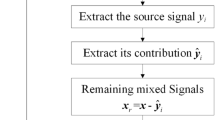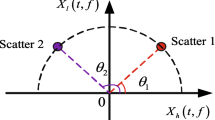Abstract
In this study, sparsity maximization nonlinear blind deconvolution (NBD) is proposed to identify the vibration sources of satellite systems from mixed vibration signals. The proposed algorithm decomposes NBD into two independent stages, namely, nonlinear compensation and blind deconvolution. Since nonlinear distortion weakens the sparsity of the observed signals, sparsity maximization is introduced to the nonlinear compensation stage. In the blind deconvolution stage, the blind deconvolution algorithm with reference is used to separate the source signals. The proposed algorithm can improve the accuracy of source signal extraction from nonlinear mixed signals of complex mechanical systems. The effectiveness of the proposed method is verified through simulations. An experimental system of aluminum cabin structure is built based on the satellite’s cabin structure. Results show that the proposed algorithm can successfully realize the identification of source signals.
Similar content being viewed by others
References
Z. Long et al., Turbo equalization based on joint Gaussian, SIC-MMSE and LMMSE for nonlinear satellite channels, Science China (Information Sciences), 61 (4) (2018) 042301.
J. Lu et al., A novel underdetermined blind source separation method with noise and unknown source number, Journal of Sound and Vibration, 457 (29) (2019) 67–91.
J. Thomas, Y. Deville and S. Hosseini, Time-domain fast fixedpoint algorithms for convolutive ICA, IEEE Signal Processing Letters, 13 (4) (2006) 228–231.
Z. Lv et al., A permutation algorithm based on dynamic time warping in speech frequency-domain blind source separation, Speech Communication, 92 (2017) 132–141.
A. Taleb and C. Jutten, Source separation in post-nonlinear mixtures, IEEE Transactions on Signal Processing, 47 (10) (1999) 2807–2820.
Z. Li and Z. Peng, A new nonlinear blind source separation method with chaos indicators for decoupling diagnosis of hybrid failures: A marine propulsion gearbox case with a large speed variation, Chaos Solitons & Fractals the Interdisciplinary Journal of Nonlinear Science & Nonequilibrium & Complex Phenomena, 89 (2016) 27–39.
G. D. Pelegrina and L. T. Duarte, A multi-Objective Approach for post-nonlinear source separation and its application to ionselective electrodes, IEEE Transactions on Circuits and Systems II: Express Briefs, 65 (12) (2018) 2067–2071.
A. Turnip and D. Soetraprawata, Feature extraction of EEGP300 signals using nonlinear independent component analysis, International Journal of Mechanical & Mechatronics Engineering, 13 (2) (2013) 38–45.
K. Dogancay, Blind compensation of nonlinear distortion for bandlimited signals, IEEE Transactions on Circuits and Systems I: Regular Papers, 52 (9) (2005) 1872–1882.
L. T. Duarte et al., Blind compensation of nonlinear distortions: Application to source separation of post-nonlinear mixtures, IEEE Transactions on Signal Processing, 60 (11) (2012) 5832–5844.
F. R. Ávila, M. P. Tcheou and L. W. P. Biscainho, Audio soft declipping based on constrained weighted least squares, IEEE Signal Processing Letters, 24 (9) (2017) 1348–1352.
M. Azghani, A. Ghorbani and F. Marvasti, Blind iterative nonlinear distortion compensation based on thresholding, IEEE Transactions on Circuits and Systems II: Express Briefs, 64 (7) (2017) 852–856.
Z. Zhang et al., A survey of sparse representation: algorithms and applications, IEEE Access, 3 (2015) 490–530.
Y. Deville and L. T. Duarte, An overview of blind source separation methods for linear-quadratic and post-nonlinear mixtures, Lecture Notes in Computer Science, 9237 (2015) 155–167.
J. M. Górriz et al., Optimizing blind source separation with guided genetic algorithms, Neurocomputing, 69 (13–15) (2006) 1442–1457.
M. S. Pedersen et al., Convolutive blind source separation methods, Springer Handbook of Speech Processing, Berlin, Germany (2008) 1065–1094.
M. Castella and E. Moreau, New kurtosis optimization schemes for MISO equalization, IEEE Transactions on Signal Processing, 60 (3) (2012) 1319–1330.
D. E. Newland, Harmonic wavelet analysis, Proceedings of the Royal Society A: Mathematical, Physical and Engineering Sciences, 443 (1917) (1993) 203–225.
Acknowledgements
This work was supported by National Natural Science Foundation of China (No. 51775410) and Science Challenge Project (No. TZ2018007).
Author information
Authors and Affiliations
Corresponding author
Additional information
Recommended by Editor No-cheol Park
Teng Gong was born in Laiyang, China in 1990. He received his B.S. degree in mechanical engineering from Xi’an Jiaotong University, Xi’an, China in 2013. He is currently pursuing a Ph.D. degree in mechanical engineering in the State Key Laboratory for Manufacturing Systems Engineering, Xi’an Jiaotong University, Xi’an, China. His research interests include BSS, intelligent diagnosis, and condition monitoring.
Zhousuo Zhang was born in Fengxiang, China in 1964. He received his M.S. and Ph.D. degrees from Xi’an Jiaotong University, Xi’an, China in 1991 and 2004, respectively. He is a Professor of mechanical engineering at Xi’an Jiaotong University. He served as a visiting scholar in the University of Southampton, Southampton, U.K., from 2006 to 2007. His current research interests include condition monitoring, fault diagnosis, and life prediction of mechanical equipment.
Rights and permissions
About this article
Cite this article
Gong, T., Zhang, Z., Luo, X. et al. Sparsity maximization nonlinear blind deconvolution and its application in identification of satellite microvibration sources. J Mech Sci Technol 34, 69–81 (2020). https://doi.org/10.1007/s12206-019-1206-0
Received:
Revised:
Accepted:
Published:
Issue Date:
DOI: https://doi.org/10.1007/s12206-019-1206-0




